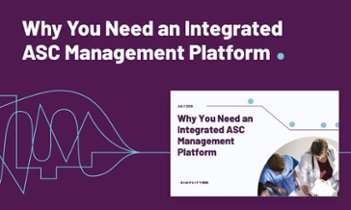
- Thought Leadership, ASC Operations
- BY: David Howerton
- Apr 16, 2019
Those who take the leadership reins in an ASC come from all parts of healthcare, but are attracted to ASC management for some of the same reasons: being their own boss, the chance to improve work/life balance, and running a surgery center the way they always believed it should be run. Still, leading requires more than meets the eye. It requires having a well-defined plan for future growth while also ensuring current levels of team efficiency and high-quality patient care.
We’ve been hanging around ASCs for about 16 years, and we’ve learned a thing or two about successful ASC leadership. Here’s some highlights.
Hearing vs. Listening
Some of the best management ideas come from those who aren't on the front lines of leadership. Successful ASC leaders empower staff to make their views heard. One administrator put it this way: “There is a difference between hearing what an employee is telling you and actually listening to what an employee is telling you… listening involves paying attention to the non-verbal cues, being aware of their feelings and in return being sensitive.” Approaching them with honesty and an awareness of their feelings goes a long way, even if the decision reached isn't the preferred choice of employees.
Leaders Eat Last…
It’s a long-held military tradition that officers file into the chow line and are served after the enlisted men and women. It’s worth noting that it’s a tradition rather than a regulation. Though the uniform is surgical scrubs, ASC leadership would do well to emulate their fatigue-clad counterparts and demonstrate how much they value their team. Leadership needs to show they empathize with everyone on the team, and they expect the team to do the same towards one another. In the intensely collaborative environment of an ASC, if leadership begins to view their staff as resources or assets that can be easily interchanged, the organization won’t function with the brisk efficiency that comes when everyone feels valued for their unique contribution.
Employee Retention is a Priority
The downstream effects of high turnover in hospitals and health systems, as well as increased demand for these high-churn jobs, intensifies the situation for ASC leadership. The turnover rate in surgical services nursing at hospitals is 13.6%, and it can take 79-108 days to recruit a replacement for an Operating Room registered nurse. For physicians over 45, turnover is 9%; for those under 45, the turnover rate climbs to 17%.
If leaders fail to value their team, they jeopardize not achieving their overarching goal of delivering excellent patient care. Creating the right company culture, which emphasizes taking care of employees who in return take care of the patient, can end up paying dividends for ASC leadership in the long run.
To hold onto staff, ASC leadership should take steps to keep morale high and frustration low. One physician owner started a monthly rounding protocol for managers. They round on each employee for five to 10 minutes to see how things are going. It’s a chance to get peer feedback on employees from their peers and identify those who are doing a great job.
The Long View
 Successful ASC leaders are in it for the long haul. Their brain space is occupied not just with today’s OR schedule, but how to navigate the changes that lie ahead — whether it's an expansion, acquisition or a dramatic shift in the regulatory environment. They develop long-range growth plans, and short-term, monthly or quarterly “pulse” plans to stay on target. This is where goals are identified, responsibilities assigned and any obstacles are laid bare.
Successful ASC leaders are in it for the long haul. Their brain space is occupied not just with today’s OR schedule, but how to navigate the changes that lie ahead — whether it's an expansion, acquisition or a dramatic shift in the regulatory environment. They develop long-range growth plans, and short-term, monthly or quarterly “pulse” plans to stay on target. This is where goals are identified, responsibilities assigned and any obstacles are laid bare.
Invest in Your People, Invest in Your Center
You've invested in your people. You've built some solid plans. At the same time, significant roadblocks to success have emerged. Good for you! You've just been handed the necessary tools to make significant changes. Strong leaders take every chance to challenge a status quo that isn't working and begin charting a new course.
For many ASC operations, one of the most significant obstacles to success is outdated, paper-driven business operations. ASCs often lack reliable data to help them identify strengths and weaknesses. Drafting reports for board meetings is a persistent burden. Resolving claims seems to take longer every billing cycle. If they do have some ASC software, the digital charting system can't communicate with the software that powers their business operations. Case costing, for example, requires double data entry, because what went on in the clinical setting can’t be integrated into the supply chain system.
Simplify ASC integrates your clinical and business workflow through a singular and complete ASC management system that includes a world-class clinical chart, a modern scheduling, claims, and inventory engine, and a powerful reporting suite that easily adapts to the needs of center leadership. Existing paper charts are digitized using our “Forms Under Glass” technology designed specifically for tablets and laptops. It eliminates multiple entry for data needed in multiple places, so you never have to enter something twice. Data flows easily between business operations and the EMR so that everything — from scheduling to claims management — runs with the smooth efficiency time-crunched ASCs need to succeed.
And because we know change is hard, we’ve made sure our implementation is nothing like you've ever experienced. Training is simple and can take as little as a few weeks to migrate your center to the new platform when you follow our implementation guidelines. We’re with you every step of the way with 24/7 support that’s local.
Stop putting out fires and start leading towards the horizon. Take a closer look at Simplify ASC.

